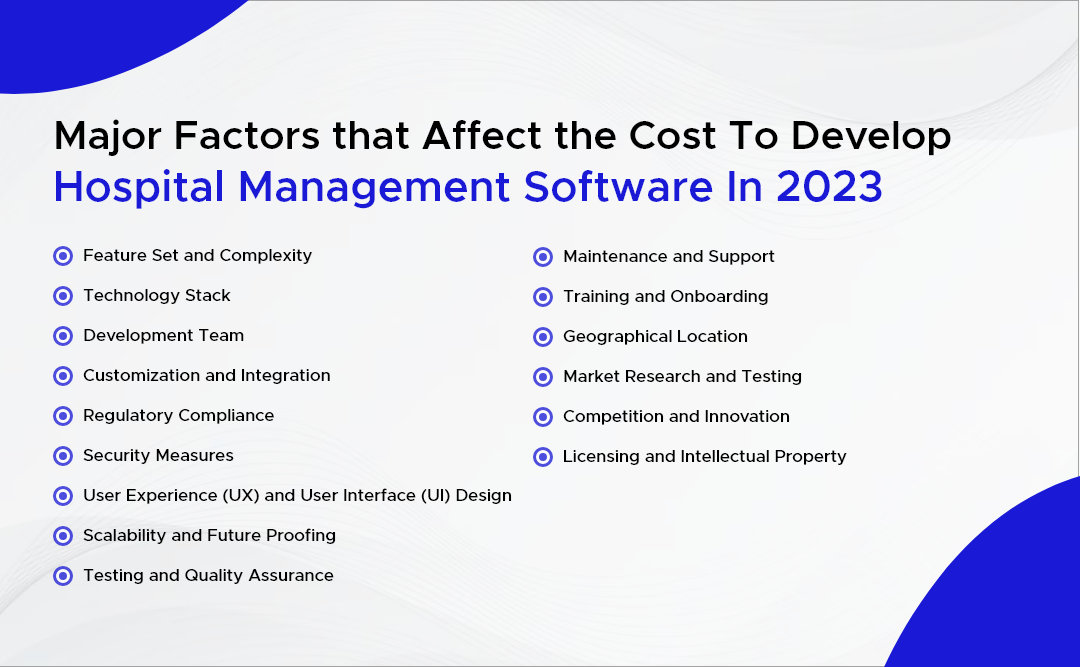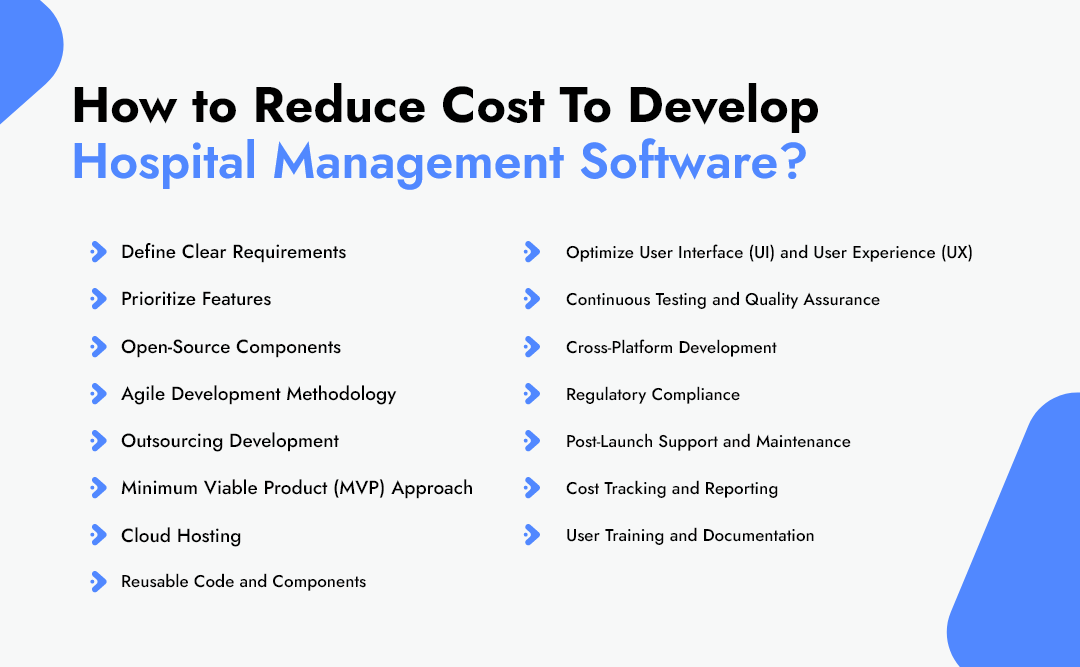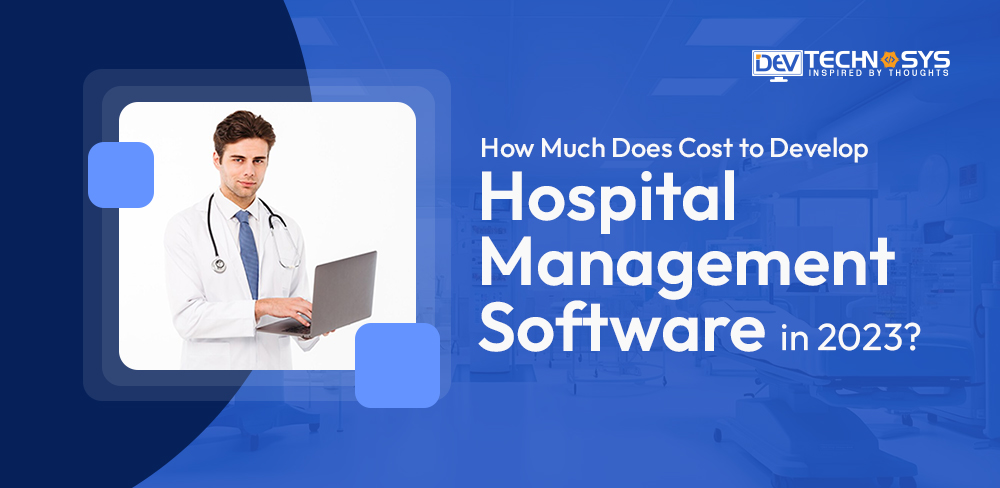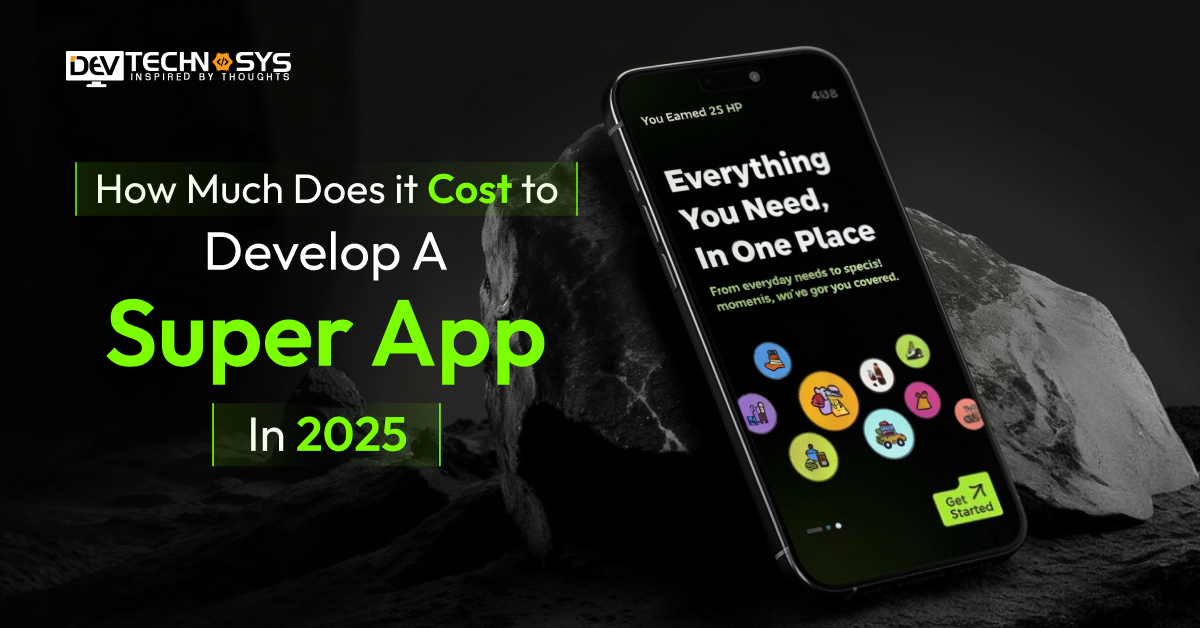In the ever-evolving landscape of healthcare, technology plays a pivotal role in streamlining operations and improving patient care. Hospital Management Software (HMS) has become indispensable for healthcare institutions, offering a digital lifeline for efficient administration and seamless patient management. However, as we step into 2024, you might be wondering about the investment required to develop hospital management software.
This blog explores the intricacies of developing hospital management software in 2024, shedding light on the factors that influence costs. We’ll delve into the essential features, technology stack, development team requirements, and the impact of industry trends, compliance regulations, and security considerations.
So if you’re a healthcare professional seeking to modernize your facility or a tech entrepreneur eyeing this lucrative niche, understanding the cost dynamics will be vital to your decision-making process. Come along on this informative journey to uncover the financial aspects of developing hospital management software.
What is Hospital Management Software?

A hospital’s administrative, operational, and clinical procedures can be streamlined and optimized with the help of hospital management software (HMS), a fully digital solution. To handle many facets of their operations, hospitals, clinics, and other healthcare organizations employ this specialized software system.
Patient registration, appointment scheduling, management of electronic health records (EHR), billing and invoicing, inventory management, staff scheduling, and reporting are some of the key features of HMS. Automating repetitive operations, cutting down on paperwork, and increasing data accuracy, increases productivity.
Additionally, HMS enables healthcare providers to access patient information securely, improve patient care, and enhance overall hospital management through data analytics and reporting tools. Overall, Hospital Management Software aims to enhance patient care, increase operational efficiency, and resulting in making healthcare apps more interactive for institutions.
Most Popular Hospital Management Software In 2024
If you want to develop hospital management software then knowing about its competitors is crucial. In this section, we have compiled a list of some of the best LIMS Software for 2024 in 2024which you must know about.
| App Name | Launch Date | Ratings | Downloads | Available Platforms |
| Epic Systems | 1979 | 4.0 (iOS) / 4.1 (Android) | 100,000+ (Android) / 500,000+ (iOS) | iOS, Android, Web |
| Cerner PowerChart | 1984 | 3.9 (iOS) / 3.8 (Android) | 50,000+ (Android) / 100,000+ (iOS) | iOS, Android, Web |
| McKesson Paragon | 1985 | N/A (as of 2021) | N/A (as of 2021) | N/A |
| Allscripts Sunrise | 1986 | 3.7 (iOS) / 3.5 (Android) | 10,000+ (Android) / 50,000+ (iOS) | iOS, Android, Web |
| Meditech EHR | 1969 | 3.5 (iOS) / 3.3 (Android) | 1,000+ (Android) / 10,000+ (iOS) | iOS, Android, Web |
| Athenahealth | 1997 | 3.6 (iOS) / 3.4 (Android) | 10,000+ (Android) / 50,000+ (iOS) | iOS, Android, Web |
| eClinicalWorks | 1999 | 3.8 (iOS) / 3.5 (Android) | 10,000+ (Android) / 50,000+ (iOS) | iOS, Android, Web |
| NextGen Healthcare | 1994 | 3.6 (iOS) / 3.3 (Android) | 10,000+ (Android) / 50,000+ (iOS) | iOS, Android, Web |
Major Factors that Affect the Cost To Develop Hospital Management Software In 2024?
In order to develop hospital management software in 2024 involves several factors that can significantly impact the overall cost of the project. Understanding these factors is essential for planning and budgeting. Here are the major factors that affect the cost to develop hospital management software in 2024:

1. Feature Set and Complexity
The features and complexity of your HMS play a crucial role in cost estimation. Basic HMS systems with features like patient registration, appointment scheduling, and billing will cost less than comprehensive solutions with advanced features like electronic health records (EHR), telemedicine integration, data analytics, and AI-driven decision support. Clearly defining your feature set is the first step in the cost to develop hospital management software.
2. Technology Stack
The choice of the technology stack, including programming languages, frameworks, and databases, can impact the cost to develop hospital management software. Some technologies are more cost-effective than others, but the selection should align with your project’s requirements and scalability. Additionally, integrating third-party tools and APIs may add to the complexity & cost to develop hospital management software
3. Development Team
The size and expertise of your development team directly affect costs to develop hospital management software. A skilled team of developers, designers, testers, and project managers will be more expensive than a smaller, less experienced team.
Consider whether you’ll hire a healthcare mobile app development company, as this decision will also impact cost to develop hospital management software.
4. Customization and Integration
Customizing the HMS to suit the unique needs of your healthcare facility and integrating it with existing systems (e.g., EMR, PACS) can significantly increase cost to develop hospital management software.
Customization involves tailoring the software to specific workflows and requirements, while integration ensures seamless data exchange between systems.
5. Regulatory Compliance
Healthcare software must adhere to strict regulatory standards such as HIPAA (in the United States) or GDPR (in Europe). Ensuring compliance with these regulations adds both development time and cost to develop hospital management software. It requires robust security measures, data encryption, and audit trails to protect patient information.
6. Security Measures
Security is paramount in healthcare software development. Implementing robust security measures, regular security audits, and encryption techniques to protect patient data can increase costs. The cost of security also includes ongoing maintenance and updates to address emerging threats.
7. User Experience (UX) and User Interface (UI) Design
A user-friendly and visually appealing design is essential for an HMS to be adopted effectively by healthcare professionals. The cost of hiring skilled UX/UI designers and conducting user testing to refine the interface can impact your overall cost to develop hospital management software. A well-designed interface can enhance user satisfaction and overall usability.
8. Scalability and Future Proofing
Consider the scalability of your HMS. Will it be able to handle increased user loads and additional features in the future? Investing in a scalable architecture may increase upfront costs but can save money in the long run by avoiding the cost of develop hospital management software.
9. Testing and Quality Assurance
Rigorous testing and quality assurance are essential in healthcare software development to ensure patient safety and data accuracy. It includes unit testing, integration testing, usability testing, and security testing. Adequate testing adds to develop hospital management software but is critical to delivering a reliable HMS.
10. Maintenance and Support
Post-launch maintenance and support are ongoing costs that must be considered. Regular updates, bug fixes, security patches, and user support can add up over time. It’s essential to have a strategy and budget for long-term maintenance to keep the HMS running smoothly.
11. Training and Onboarding
Training healthcare staff to use the new HMS can incur costs related to curriculum development, training materials, and instructor time. Consider the time and resources required to onboard users effectively to maximize the benefits of the software.
12. Geographical Location
The cost to develop hospital management software can vary based on the geographical location of your development team or outsourcing partner. Different regions have different labour rates and overhead costs, which can influence your budget. Consider the cost-benefit trade-offs when deciding where to source your hospital management software developers.
13. Market Research and Testing
Prior to develop hospital management software, investing in comprehensive market research and user testing can impact your budget. Understanding the needs and preferences of your target audience can help you create a more focused and cost-effective solution.
14. Competition and Innovation
The competitive landscape and the level of innovation in the healthcare software market can influence your cost to develop Hospital Management Software. Staying ahead of or in line with industry trends may require additional research and development efforts.
15. Licensing and Intellectual Property
If you plan to develop a hospital management system includes third-party software components or libraries with licensing fees, or if you want to protect your intellectual property through patents or copyrights, these legal and licensing costs should be factored into your budget.
What is The Accurate Hospital Management Software Cost?
The hospital management software development cost varies significantly, influenced by factors such as app size, feature set, technology stack, complexity, and more.
On average, the hospital management software cost typically falls within the range of $8,000 to $30,000 or even higher, depending on the specific requirements and complexity of the software.
Get in touch with a reputable hospital management software development company can make the development process more cost-effective.
| Category | Cost Range |
| Planning and Design | $2,000 – $5,000 |
| Development | $10,000 – $30,000 |
| Testing and QA | $5,000 – $8,000 |
| Deployment | $3,000 – $7,000 |
| Security and Compliance | $5,000 – $8,000 |
| Maintenance and Support | $5,000 – $10,000 |
| Marketing and Launch | $10,000 – $15,000 |
Alternatively, you can opt to hire dedicated hybrid app developers to assist in creating Hospital Management Software at a reasonable expense. This tabulated breakdown offers an estimation of Hospital Management Software costs. Armed with this budgetary insight, you can plan your project accordingly.
How to Save Cost To Develop Hospital Management Software? 7 Monetization Techniques
Developing Hospital Management Software (HMS) can be a substantial investment, but there are ways to save costs and potentially generate revenue to offset development expenses. In this guide, we’ll explore seven monetization techniques that can help you save costs to build healthcare software and make it financially sustainable.

1. Freemium Model
One effective strategy to save development costs and attract users is to offer a freemium model. Provide a basic version of your HMS for free with essential features like patient registration and appointment scheduling. Then, offer premium features or advanced modules, such as electronic health records (EHR) management or telemedicine integration, for a subscription fee.
This approach not only helps acquire a large user base but also generates recurring revenue from users who require advanced functionalities. It’s important to know role of mobile apps in the healthcare industry to strike a balance between the free and premium offerings to entice users to upgrade while still finding value in the free version.
2. Subscription-based Pricing
Implementing a subscription-based pricing model can help cover ongoing maintenance costs and ensure a steady stream of revenue. Offer different subscription tiers with varying levels of functionality, allowing users to choose the plan that best suits their needs. Monthly or annual subscriptions provide predictable income and encourage user retention.
Additionally, you can offer discounts for annual subscriptions, providing an incentive for users to commit to a longer-term plan. To save on development costs, prioritize the development of features that are essential for the subscription plans and gradually add more advanced features over time.
3. Pay-per-Use Model
A pay-per-use or pay-per-transaction model can be advantageous for HMS systems that offer specific services, such as billing and insurance claim processing. Users are charged based on their actual usage or the number of transactions processed through the system.
This approach aligns costs with revenue and can be particularly beneficial for healthcare facilities with varying patient volumes. However, it’s essential to ensure transparent pricing and cost calculations so users understand the charges and find value in the services provided.
4. Licensing and Integration Fees
Consider charging licensing fees for the use of your HMS system, especially if it includes proprietary features or modules. You can also charge integration fees for connecting your HMS with other healthcare systems, such as electronic medical records (EMR) or picture archiving and communication systems (PACS).
This approach allows you to monetize your software’s uniqueness and the value it brings to healthcare facilities. Ensure that your pricing is competitive and offers cost-effective solutions compared to building custom integrations or using alternative software.
5. Marketplace for Add-ons and Extensions
Create a marketplace or ecosystem for add-ons and extensions that can be integrated with your HMS. Allow third-party developers to build and sell modules or plugins that enhance your healthcare software development solutions capabilities. In return, you can take a commission from each sale, providing a source of revenue without the need for significant development efforts.
This approach also encourages a community of developers to contribute to the growth of your HMS, expanding its functionality and attracting a broader user base. To save cost to develop hospital management software, focus on creating robust APIs and documentation to facilitate third-party development.
6. Data Analytics and Insights
Leverage the data collected by your HMS to provide valuable insights and analytics to healthcare facilities. Offer advanced reporting and data visualization tools that enable hospitals and clinics to make informed decisions and optimize their operations.
Charge a fee for access to these analytics features, either on a subscription basis or per report generated. This monetization technique not only helps save development costs but also positions your HMS as a valuable tool for healthcare administrators seeking to improve efficiency and patient care.
7. Telemedicine and Consultation Services
Integrate telemedicine capabilities into your HMS and offer consultation services. Healthcare providers can use your platform to connect with patients remotely, providing medical advice, follow-up appointments, or prescription renewals. Charge a percentage fee for each telemedicine session facilitated through your platform.
This monetization approach not only generates revenue but also enhances the value of your trending app & web solutions by expanding its utility beyond administrative and record-keeping functions. To save on development costs, you can initially focus on basic telemedicine features and gradually introduce more advanced functionalities.
How to Reduce Cost To Develop Hospital Management Software?
Reducing the cost of developing Hospital Management Software (HMS) is a crucial consideration for businesses and developers aiming to create a cost-effective and efficient healthcare management solution.
In this comprehensive guide, we’ll explore numerous strategies and techniques to help you minimize cost to build hospital management software while ensuring the quality and functionality of your HMS.

1. Define Clear Requirements
Begin by thoroughly defining your project’s requirements. A detailed specification will help prevent scope creep, which can lead to increased development time and costs. Involve key stakeholders, healthcare professionals, and IT experts to create a comprehensive list of features and functionalities needed for your HMS. A well-defined scope will also facilitate accurate cost estimation.
2. Prioritize Features
Prioritization is essential when developing an HMS on a budget. Start with essential features that are critical for the core functionality of the hospital management software development, such as patient registration, appointment scheduling, and billing.
As your budget allows, gradually implement additional features and modules. This phased approach helps control costs and allows for adjustments based on user feedback.
3. Open-Source Components
Leverage open-source software and libraries whenever possible. Many open-source solutions offer robust and cost-effective alternatives to proprietary software. For example, you can use open-source databases like PostgreSQL or MySQL or utilize open-source frameworks and tools to accelerate development without incurring licensing fees.
4. Agile Development Methodology
Adopt an Agile development methodology to streamline the development process. Agile allows for flexibility and an iterative hospital patient management system, which can help identify and address issues early in the project, reducing the cost of fixing problems in later stages. It also facilitates collaboration between development teams and stakeholders, leading to a more efficient and cost-effective development process.
5. Outsourcing Development
Consider outsourcing development to regions with lower labour costs. Outsourcing can significantly reduce development expenses while maintaining high-quality standards.
Ensure that you choose a reputable full-stack development services provider with experience in healthcare software development. Effective communication and project management are key to the success of an outsourced project.
6. Minimum Viable Product (MVP) Approach
Start with an MVP – a simplified version of your HMS that includes only the core features necessary for a functional product. An MVP allows you to enter the market quickly, gather user feedback, and make informed decisions about feature development. It also minimizes initial hospital management software solution costs, enabling you to test your concept before investing heavily.
7. Cloud Hosting
Utilize cloud hosting services like Amazon Web Services (AWS), Microsoft Azure, or Google Cloud Platform (GCP). Cloud hosting offers scalability and cost-efficiency, as you only pay for the resources you use. It eliminates the need for expensive infrastructure investments, hardware maintenance, and on-site server management.
8. Reusable Code and Components
Custom software development company can save time and costs by creating reusable code and components. Building a library of reusable modules, templates, and design patterns allows for faster development and consistency across the application. Reusing code also reduces the risk of errors and improves code maintainability.
9. Optimize User Interface (UI) and User Experience (UX)
Invest in a user-friendly design that focuses on essential features and a clean interface. Prioritize usability testing to ensure that the user experience is intuitive and efficient. An intuitive design reduces the need for extensive user training and support, ultimately saving on both development and operational costs.
10. Continuous Testing and Quality Assurance
Implement rigorous testing and quality assurance processes throughout development to catch and address issues early. Automated testing tools can help identify bugs and performance bottlenecks, reducing the time and costs associated with manual testing and post-release bug fixes.
11. Cross-Platform Development
Consider cross-platform development frameworks like React Native, Flutter, or Xamarin for mobile app components of your HMS. These frameworks allow you to write code once and deploy it on multiple platforms, saving on-demand app development solutions time and resources compared to building separate native apps for iOS and Android.
12. Regulatory Compliance
Stay informed about healthcare regulations and compliance requirements, such as HIPAA, in the United States. Ensure that your hospital management system development company has a strong understanding of these regulations to avoid costly legal issues or fines due to non-compliance.
13. Post-Launch Support and Maintenance
Plan for ongoing support and maintenance to address issues, updates, and enhancements post-launch. Budgeting for maintenance is essential to keep the HMS running smoothly and to prevent costly downtime or emergencies.
14. Cost Tracking and Reporting
Implement robust cost-tracking and reporting mechanisms throughout the process to build an app like Practo. Regularly monitor expenses and compare them to your budget. This proactive approach allows you to identify potential cost overruns and make necessary adjustments.
15. User Training and Documentation
Invest in user training and documentation to ensure that healthcare professionals can effectively use your HMS. Well-trained users are less likely to encounter issues or require extensive support, ultimately reducing support costs.
Final Thoughts!
In conclusion, the cost to develop app like Seha in 2024 can vary widely based on numerous factors, including feature complexity, technology choices, and regulatory compliance. While the average cost ranges from $8,000 to $30,000 or more, careful planning, prioritization, and cost-saving strategies can help manage expenses effectively.
It’s crucial to strike a balance between cost efficiency and delivering a high-quality, functional HMS that meets the needs of healthcare facilities and professionals. So if you are someone who wants to develop hospital management software then it is crucial to hire dedicated developers.
FAQ
1. What factors influence the cost of developing Hospital Management Software in 2024?
Factors like feature complexity, technology stack, and regulatory compliance significantly impact development costs.
2. Is there a ballpark figure for the average cost of HMS development in 2024?
On average, hospital management system software costs can range from $8,000 to $30,000 or more, depending on specific requirements.
3. How can I reduce the cost of developing Hospital Management Software?
You can minimize costs through clear requirements, prioritization, open-source tools, and efficient hospital management software practices.
4. What are some essential features to consider when budgeting for HMS development?
Key hospital management software features include patient registration, appointment scheduling, billing, and regulatory compliance features.
5. How can I ensure a cost-effective HMS without compromising quality and security?
Balancing cost-effectiveness with quality involves smart planning, agile development, outsourcing, and meticulous cost tracking throughout the project.














